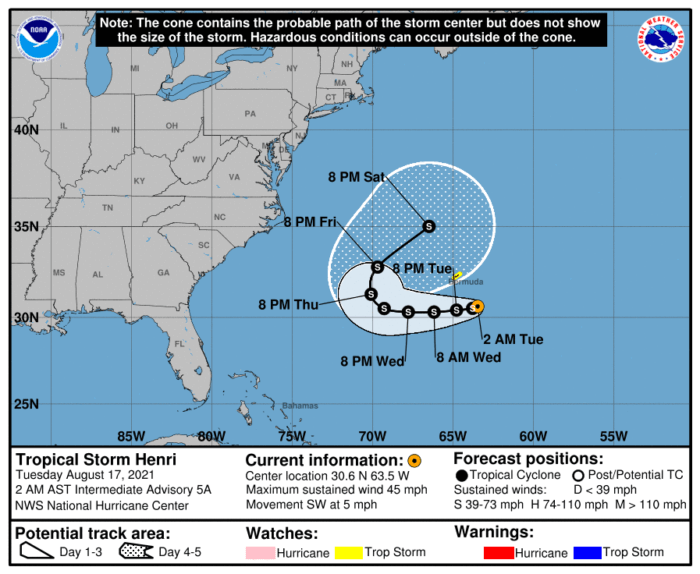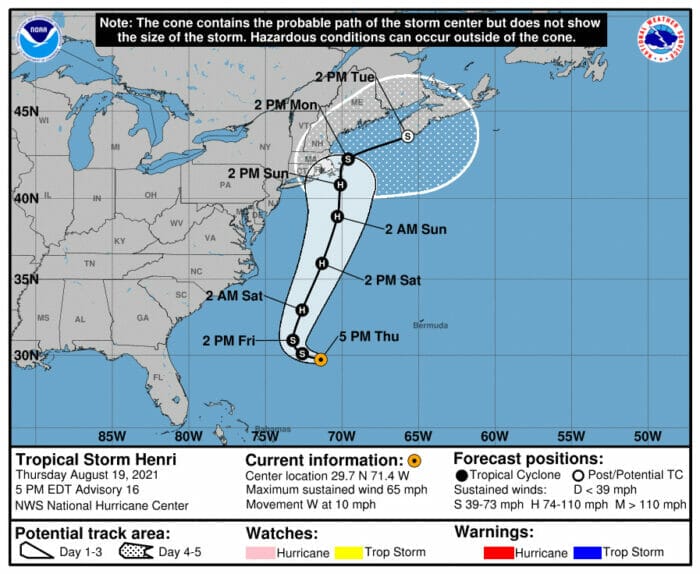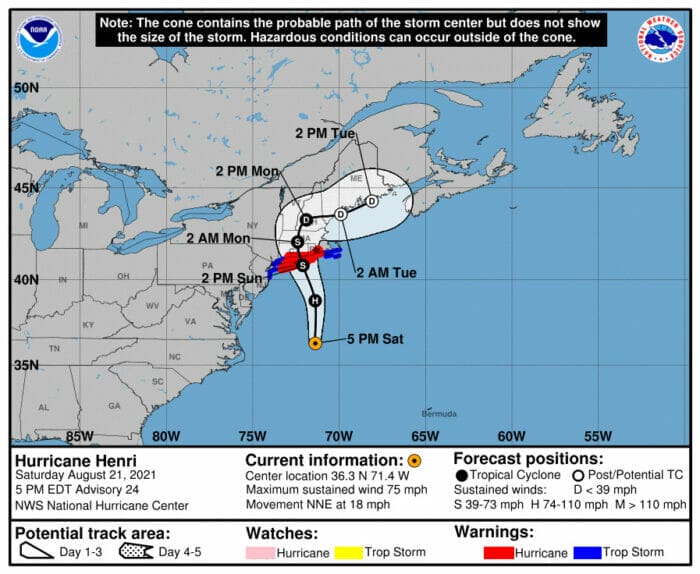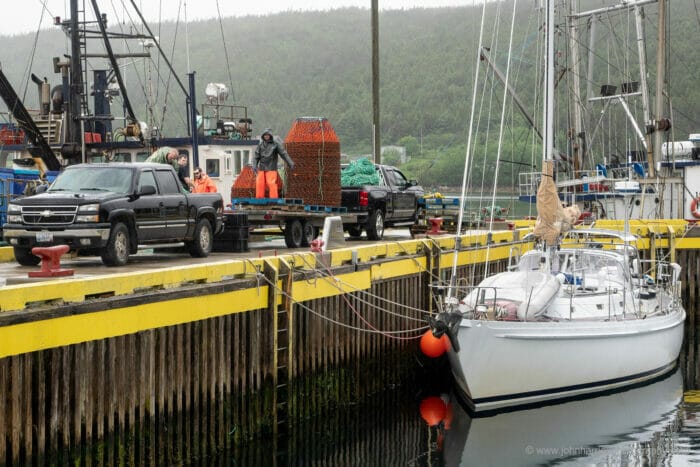


A couple of weeks ago I got a text from a cruising friend homeward bound from the Bras d’Or Lakes to the St. John River, New Brunswick, asking if he could hang out on our mooring (in one of the best hurricane holes in the area) for a few days while Hurricane Henri decided what the hell it was going to do.
There was simply no way that our friend was going to risk a meeting with Henri in the vicinity of Cape Sable, with its thick fog, four-knot tides and limited sheltered anchorages, even though the later forecasts were calling for the storm to dissipate, and he needs to be home as soon as he can.
Our friend definitely obeys the same rule Phyllis and I do:
Never sail in the same ocean with a hurricane
Instead, find the best shelter possible, well ahead of time, and wait until the thing dissipates, even if the forecast indicates that it won’t come anywhere near our intended route…and screw the calendar.
Phyllis and I have modified that when we can jump to another really good hurricane hole, but even that approach is one we only take with plenty of time in hand to account for a problem, say an engine failure and no wind, slowing us down on the transit between the two hidey-holes.

And that reminds me of a Twitter exchange I saw some years ago:
We are in the BVI and are leaving now for Grenada to avoid hurricane…
An experienced cruiser and circumnavigator
You should have left three days ago.
Gary (Captain Fatty) Goodlander, one of the most experienced voyagers on the planet and a three-time circumnavigator
Further Reading
- Weather Reception and Analysis Online Book, including how to assess the risk of an un-forecast outcome using upper level charts
- How we handled it when Hurricane Maria ignored the forecast in 2011
- Hurricane preparation checklist
A Graphic Example
Click on the button below for a ¹graphic example of how the forecasts for Henri changed over time—deeply sobering.
¹Thanks to member Robert for the heads up.

I just rode out Hurricane Ida on a drill ship. We were about 50-60 miles from the center of the storm. I saw 50′ waves and 60+ knot winds. It was an uncomfortable ride for 36 hours and we are over 700′ long! Another rig was much closer to the storm center and saw 90′ waves and 100+ knots and suffered damage. I can say without equivocation: don’t sail in a hurricane, it’s not fun. Ida came in on us faster and stronger than we had expected and we have expert weather forecasters working for us 24hrs/day. Stay safe out there!
-bill
Hi Bill,
A sobering experience indeed, particularly that the storm surprised your forecasters since I know the firms that do that for the oil industry are some of the best in the business.
They are very good at what they do for sure. However predicting the exact path, strength and timing can be so variable. 50 miles can mean the difference between a breezy afternoon and life threatening conditions.
-bill
HiBill,
So true and something many people miss.
Words to live by.
100% agree. It worries me that a current trend is for bigger, faster cruising multihulls with the argument that they are fast enough to get out of the way of storms and that makes them safer.
It puts a huge reliance on expensive technology to be able to get forecasts and expert routing while at sea. It puts huge reliance on nothing failing when speeding out of the way of a hurricane (or even a gale).
Deliberately choosing to have so many potentially catastrophic single points of failure is not our idea of safety.
As the effects of climate change on weather become ever more dramatic and extreme a cautious approach seems obvious. For us part of that is choosing a boat designed and built when there was no expectation of being able to avoid all storms while at sea.
Hi Dave,
I think we agree, but I just wanted to elaborate on the advantage of boat speed. I’m one of those sailing fast cats and liking the extra tool that gives us. A boat that can keep a reliably high average for days, can choose to be in an entirely different area when something fishy seems to approach. If that ability is used just to delay the decision to move out of the way, it’s not smart, of course. That’s a bit like saying; “yeah, I see that avalanche approaching the road ahead of us, but we have such good breaks that we don’t need to use them yet.” The brakes are not the actual problem here. 🙂
I think the main advantage of a very fast boat is that when we’re actually out there and something suspicious comes up, we are less resistant to making a big detour, since the effort and time delay consequences are still not too bad.
One example is when we sailed from Guadeloupe to the Acores about 18 years ago. 5 days in, we got Inmarsat routing info saying that a storm was brewing east and north of us. We decided that we would not take any risks, so we set the course to 220 degrees, southwest, pretty close to going straight back. We kept that heading for about 2 days, gradually turning south and then east.
The standard route for this passage is north to Bermuda, then straight east to the Acores. We effectively inverted that, going straight east and then north the last bit. This would normally have given us zero wind the last 30% of the trip in the “Acores high”. It was light, but the high was further south than normal and having a fast boat, we still kept about 7 knots average. We had max 25 knot sustained wind during the entire crossing and effectively lost about 3 days on our detour, but still were there in 14 days total. This was a 39 foot light and relatively fast cruising cat, no racer.
The monohulls mostly left earlier than us, and arrived some days later, even though they didn’t make detours and had a horrible crossing, following the standard route further north. One boat (Bavaria 41) had rolled and miraculously didn’t loose the rig, but the bilge water had made “proof in the roof”… 🙂 The ceiling plates showed clearly that the boat had spent some time upside down. They said a couple of minutes and that most of it (not the flip) went surprisingly slow.
My point with this story is that our speed capacity meant that we didn’t feel any resistance against making the right choices and avoiding the bad weather. Had we been on a similar size typical cruising mono, I don’t think we would have chosen the same smart route. We probably would just have soldiered on, which could have been bad, if we were less lucky than the mentioned rolled boat.
The reason for avoiding the weather was not an especially vulnerable boat. It wasn’t. We had already sailed same boat and same people in a hurricane, sustained +60 knot wind and insanely big waves some years earlier, when we didn’t pay attention to warnings… We handled that totally fine, absolutely zero damage and no close calls. Still we had learned our lesson and felt it was easy to be smarter this time.
I think it’s easy to get lazy with decisions, no matter what causes the laziness. Having a good tool can make us lazy. It’s still better to have the good tool than not having it. We just have to work a bit with our minds, or as I did; get scared enough to forever be suspicious around potential storms.
Stein,
I agree we are probably pretty much in agreement.
I’m not against speed, in our huge refit of a 44 year old Rival 38 we are including lots of things that will improve sailing speed (even more important as we are switching to an electric motor).
Specifically a couple of high profile Tube channels irritated me for what they are teaching, which includes speed eg
a) la Vagabonde: we are staying in the Bahamas through hurricane season because i) family can fly out of the way ii) skipper can sail out of reach of any hurricane because we are so fast.
This puts others in danger because privileged visitors take available flights out, preventing others from doing so. It fails to take into account how often Riley breaks things and is unable to fix them – assuming everything will be working at the point a hurricane is forecast with so many single points of failure is not good advice imho.
b) again la Vagabonde: we are choosing an incredibly fast 60 foot tri for our next boat because this is the safe option. Implying that anyone not making this very expensive, very unsustainable choice is not taking safety seriously.
c) Ruby Rose for all their pontificating about their buying a huge Seawind cat. For all their privilege and lack of understanding or consideration for others. With their beautiful fast monohull they sailed for something like 15 days in a whole season, despite claiming privileges to travel in lockdown. Their normalisation of wealth and luxury (eg apparently walk around double beds are now an essential). Their normalisation of frequent flying, buying a brand new large cat while claiming to be sustainable.
Both these for using their high profiles to promote an elitist, luxury, high carbon footprint sailing “lifestyle” as being the safe option that everyone needs to choose.
It is dangerous and toxic. Also it has pushed me into an angry rant, my apologies for that.
Dave
👏🏻👏🏻👏🏻
Hi David,
Normally I discourage rants of this type, but I have to say that this one struck a couple of cords with me.
La Vagabond have taken a lot of stupid risks over the years and one day this will catch up with them.
I’m also thinking a lot lately about folly of building brand new boats with huge attendant carbon impact from the build and then claiming to be green by sticking an electric drive in them.
Hi Dave,
Yup, I can sign on to your rant too. 🙂
However, there might also be points to defend the mentioned YouTubers.
Their total resource consumption is far higher than it could have been with a more minimalist attitude. Sailing Uma, Alluring Arctic, NBJS, and many more channels are proof of that. Still, they live on their boats full time and have no house, no car, no AC, etc. Most of their daily energy consumption is from sun and wind. I have no actual data, but my wild guess would be that their average total “resource consumption” might be a lot lower than an average well off same size household in the western world, if everything is counted. That’s not saying that their consumption is OK, not at all. It’s saying that well off people in the west mostly live extremely wasteful lives, which is unacceptable.
La Vagabonde is mainly an entertainment channel. Their choices are made mainly to fit that function. Even though it seems like Elena and Riley have real interests in sustainability, their viewers and livelihood are mostly the people I call “unacceptable “just above here. Their main choices are made to fit entertaining them. That way they are also giving the public living in an “unacceptable” way a feeling of being out there in the free living nicely. That might sustain their illusion of being nice people for a longer time. A bit too harsh to say normal people are not nice, of course. I still think it’s fair, as long as they use wilful ignorance as a tool to keep a clear conscience while doing nothing to improve.
I wish a channel criticising “our way of living” and slaughtering our good conscience could have a big following and generate enough to sustain that channel. Maybe it is possible, but I doubt if it’s easy to maintain that. Showing attractive happy people is easy. I understand how mostly choosing easy is appealing. That’s how I can criticise people for being “not nice” and “unacceptable”, while still being close friends with many of those. I also choose easy, but at least I try to improve what I can. Always really trying is, in my eyes, always good enough.
Now, linking this rant to how they influence other sailors and their storm strategies… I think they may occasionally give some naive wannabe ocean sailors the illusion that we don’t need to worry much. Not good, of course, but maybe we can attribute it to the fact that nobody’s perfect? The youtubers put most of their life out there. Some of it is bound to be not really well sorted out.
OK. I don’t think I can make anybody wiser with more of this, which means I’ll shut it. 🙂
Nice rant, Dave 👍
I guess we’re simply not their target audience. They make entertainment videos for dreamers and don’t intend to be subjected to reallity checks.
Sailing you tube channels awful made only to sustain their freak lifestyle . Never trust to them.
Not in the “same ocean”? A little hyperbole, I think, Sometimes on passage getting out of the entire North Atlantic whenever a tropical system pops up is not an option. The graphics show that five day forecasts can be wildly inaccurate – but two day forecasts are pretty damn good. Our rule of thumb is to stay five hundred miles from the five day forecast, four hundred from the four day forecast, three hundred from the three day forecast, etc. Or have snug shelter in that time frame. It worked for us with Henri – we left Eastport, ME hoping to go to the Cape Cod Canal on August 18 based on that first graphic, knowing there was a good chance we would have to divert. Based on the second graphic, we pulled into South Bristol on the Damariscotta, ready to go further up the river for a snug hole if the forecast held. Based on the third forecast, we left South Bristol for the Cape Cod Canal on Sunday afternoon and had a fast and pleasant overnight passage in the 10-15 kt fringe easterlies from Henri, making it through the Canal Monday afternoon. All this in a 40 year old Wauquiez, not a fast new catamaran. Admittedly, we could have holed up in Eastport as soon as Henri was out there. And we would still be there in Eastport, in that case, since Ida became a potential threat nearly as soon as Henri went away. All tropical systems demand respect, but with access to the latest forecasts, a sailing boat at sea that can make reasonably good speed can stay out of the way.
Agree with the hyperbole. The UK has had some lovely weather while these hurricanes have been hitting the other side of the Atlantic.
Me thinks you take me a little too literally. I would argue that’s it’s clear that’s not what I meant given the rest of the post and particularly this sentence:
John,
I think the hyperbole is a helpful starting point. However, my point was that even the sentence you included about jumping to another really good hurricane hole isn’t always relevant, even for a long passage on the other side of an ocean.
So for example consider Peter Lawless, who is on a solo non-stop circumnavigation (plans to be the first Irish citizen to complete this). He has been at sea in the Atlantic during these recent hurricanes without any issues.
I think it is helpful to be aware that seasons and risks vary a great deal from one side of an ocean to the other. Hurricane holes are not something that are relevant to the UK and Europe (although we can get extreme storms they don’t have the same circular challenges as a hurricane).
Dave
Hi Dave,
I do know that. I have cruised Europe extensively and the North Atlantic for 40 years. It’s not my first day on the job. A short article like this can’t cover ever side of the issue. The idea was to point out that hurricane forecasts are not as accurate as many people think they are and to refer people to an interesting graphic that shows that, not provide a full on discussion of hurricane risk management. I would have thought that was obvious.
John,
I know you know it. I thought the article was both helpful and interesting.
However, it does feel excluding to talk of a whole ocean when advising on hurricanes that affect (in a terrible way) the western side of the ocean but not the European & African side of the Atlantic.
We have different issues relating to storm risk management.
Hi Karl,
I agree a bit of hyperbole. Makes the story go you know.
That said, you were not at sea, but rather on a coast with a lot of good hurricane holes and it sounds like you handled the challenge well, albeit pushing a little harder that I probably would have.
However there’s a big difference when a longer passage is contemplated. For example, setting out for Bermuda from Maine with an active hurricane in the Caribbean could be a deeply stupid thing to do even though the storm might be 1700 miles south of Maine and 1000 miles south of Bermuda the day we left. In that case the hyperbole works.
A drill ship in the Gulf of Mexico, with state of the art equipment and access to excellent weather forecasts messed up their T- time (time to be a safe distance from Hurricane) and got caught in the top right quadrant of Hurricane Ida, about 17 NM from the edge. They could not recover about 8000 ft of riser in time, which restricted their escape speed as many thousands of feet was still hanging below the vessel. The vessel was caught in the full force of the hurricane, holed, equipment washed overboard. These vessels are very compartmentalised and the breech was contained and pumps kept the water level in check. They manage hurricanes every year as the GOM is their area of operation. We have to be wary of complacency when such forces can be unleashed and track variables can’t be assessed in a meaningful time frame for the speed most sailing yachts, are capable of.
https://youtu.be/LCFlXrh29cc
If my sources are correct, they were having well control issues that may have delayed their ability to move off location in an appropriate time frame. Well control is when you are taking losses to the well or a kick into the well bore. These issues are serious and have to be dealt with before you are able to close the BOP and detach the LMRP. Sadly it looks like they were unsuccessful and lost the riser and LMRP.
-bill
Given the oil industries funding of climate change disinformation while planning for the consequences in their infrastructure, it’s good to know they still get their due from time to time, given nobody gets hurt, beyond everyone who is ….
Hi Alastair and Bill,
I only understand about a quarter of what you two are discussing, but even that amount is sobering indeed.
Glad they got out of it safe and sound, but it does highlight the added dangers of something really horrible happening as climate change accelerates.
Sobering footage indeed. Love the shot of the guy donning a survival suit with the hurricane blowing just outside the glass. Thanks for sharing!
We tried to run away from Henri. Gave up and found a floating dock on tall pilings in Three Mile Harbor. Stripped the boat and slept ashore.
The next week found us in the path of Idas remnants. Yuk.
Given some of the wandering forecasts, finding a secure hole in advance can be the best thing to do.
The Henri and Ida problem for us was that the entire northeast coast was threatened at one time or another.
Hi David,
You are right, this stuff can be seriously stressful, particularly when it seems like the damned things are hunting us.